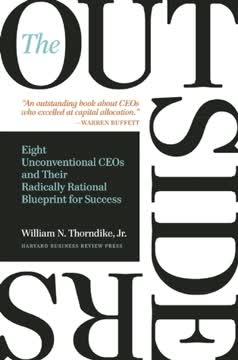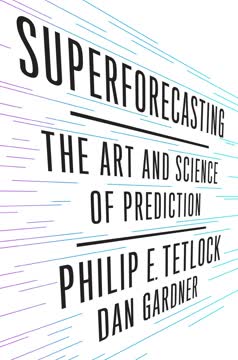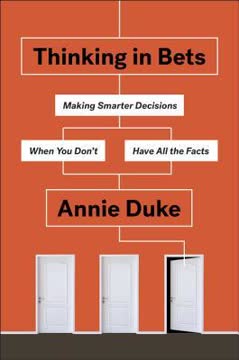Key Takeaways
1. Untangling skill and luck is crucial for accurate predictions
Untangling skill and luck helps with the challenging task of prediction, and better predictions lead to greater success.
Understanding contributions. Recognizing the relative contributions of skill and luck is essential for interpreting past results and making better future decisions. This understanding allows us to:
- Avoid overreacting to short-term outcomes
- Properly attribute success and failure
- Make more accurate predictions about future performance
Practical applications. This concept applies to various fields:
- Sports: Evaluating player and team performance
- Business: Assessing company strategies and executive decisions
- Investing: Analyzing portfolio returns and manager performance
By distinguishing between skill and luck, we can develop more effective strategies, allocate resources more efficiently, and make better-informed decisions across multiple domains.
2. Most outcomes result from a combination of skill and luck
Much of what we experience in life results from a combination of skill and luck.
Skill-luck spectrum. Few outcomes are purely the result of skill or luck alone. Instead, most fall somewhere on a spectrum between these two extremes:
- Pure skill: Chess, running races
- Mostly skill: Basketball, manufacturing processes
- Mixed: Baseball, stock picking
- Mostly luck: Roulette, lottery
Acknowledging both factors. Recognizing the dual influence of skill and luck helps us:
- Avoid overconfidence in success
- Maintain resilience in the face of failure
- Make more nuanced assessments of performance
Understanding this combination allows for a more balanced approach to decision-making and evaluation, both in personal endeavors and professional contexts.
3. The luck-skill continuum helps assess activities and make decisions
To understand the relative contributions of skill and luck and how to use that understanding in interpreting past results as well as making better decisions in the future.
Continuum concept. The luck-skill continuum is a tool for visualizing where different activities fall between pure luck and pure skill. This framework helps in:
- Assessing the nature of various activities
- Determining appropriate strategies
- Setting realistic expectations
Decision-making applications:
- Skill-dominated activities: Focus on improving abilities and techniques
- Luck-dominated activities: Emphasize process and long-term results
- Mixed activities: Balance skill development with risk management
By understanding where an activity lies on this continuum, individuals and organizations can tailor their approaches, allocate resources more effectively, and make more informed decisions.
4. Reversion to the mean is a powerful statistical phenomenon
Reversion to the mean says that an event that is not average will be followed by an event that is closer to the average.
Understanding reversion. Reversion to the mean is a statistical concept that explains why extreme outcomes tend to be followed by more average ones. This phenomenon is crucial for:
- Interpreting past performance
- Making predictions about future outcomes
- Avoiding overreaction to short-term results
Key implications:
- Exceptional performance often combines skill and luck
- Future performance is likely to be closer to the average
- The rate of reversion depends on the skill-luck ratio of the activity
Recognizing reversion to the mean helps prevent common mistakes such as:
- Overvaluing recent performance
- Misattributing causes to random fluctuations
- Making poor decisions based on short-term data
5. Deliberate practice is key to developing expertise in skill-dominated activities
Deliberate practice pushes people to attempt what is beyond the limits of their performance.
Elements of deliberate practice:
- Focused, goal-oriented training
- Immediate and informative feedback
- Repetition and refinement of skills
- Pushing beyond comfort zones
Applying deliberate practice:
- Identify specific areas for improvement
- Design targeted exercises or drills
- Seek expert guidance and feedback
- Consistently practice over extended periods
Deliberate practice is most effective in domains where:
- Outcomes are primarily determined by skill
- Clear feedback is available
- Performance can be objectively measured
Examples include:
- Music: Mastering complex pieces
- Sports: Refining techniques and strategies
- Professional skills: Developing expertise in specific areas
6. Focus on process, not outcomes, in luck-dominated fields
When luck plays a large role, the focus must be on process.
Process over results. In activities heavily influenced by luck, short-term outcomes can be misleading. Focusing on the process allows for:
- Consistent decision-making
- Long-term improvement
- Resilience in the face of short-term setbacks
Key aspects of a good process:
- Analytical rigor: Using data and evidence to inform decisions
- Psychological discipline: Managing emotions and biases
- Organizational alignment: Ensuring all parts of the system work together
Examples of process-focused approaches:
- Investing: Developing a sound investment strategy rather than chasing hot stocks
- Business: Building robust systems and practices rather than relying on short-term results
- Sports: Emphasizing player development and team strategy over individual game outcomes
By prioritizing process over outcomes, individuals and organizations can make better decisions and achieve more consistent long-term success in luck-dominated fields.
7. Useful statistics are both persistent and predictive
Useful statistics have two features. First, they are persistent, which means what happens in the present is similar to what happened in the past. ... Good statistics are also predictive of the goal you seek.
Characteristics of valuable statistics:
- Persistence: Consistent across time periods
- Predictive power: Correlates with desired outcomes
Evaluating statistics:
- Calculate correlation between periods to assess persistence
- Determine relationship between statistic and goal to gauge predictive power
Examples of useful statistics:
- Sports: On-base percentage in baseball (persistent and predictive of runs scored)
- Business: Customer satisfaction scores (often persistent and predictive of future sales)
- Investing: Expense ratios (persistent and predictive of long-term returns)
By focusing on statistics that exhibit both persistence and predictive power, decision-makers can:
- Make more accurate forecasts
- Identify key performance indicators
- Allocate resources more effectively
8. The paradox of skill: As skill improves, luck becomes more important
As skill improves, performance becomes more consistent, and therefore luck becomes more important.
Understanding the paradox. As competitors in a field become more skilled, the differences in their abilities narrow, making luck a more significant factor in determining outcomes. This concept applies to various domains:
- Sports: Elite athletes with similar skill levels
- Business: Highly competitive industries
- Investing: Efficient markets with skilled participants
Implications of the paradox:
- Increased importance of marginal advantages
- Greater difficulty in sustaining superior performance
- Need for continuous innovation and improvement
To navigate this paradox, individuals and organizations should:
- Focus on developing unique strengths or strategies
- Seek out new areas of competition where skill gaps still exist
- Recognize the increased role of luck in short-term outcomes
9. Checklists improve performance in complex environments
Checklists are highly effective but underutilized in jobs that combine probabilistic tasks with tasks that follow a set of rules or set procedures.
Benefits of checklists:
- Ensure critical steps are not overlooked
- Reduce errors in routine tasks
- Improve decision-making under pressure
Effective checklist design:
- Keep it short and focused
- Use clear, actionable language
- Test and refine based on user feedback
- Include both routine and emergency procedures
Applications of checklists:
- Healthcare: Surgical safety checklists
- Aviation: Pre-flight and emergency checklists
- Investing: Due diligence checklists for evaluating opportunities
- Project management: Quality assurance checklists
By implementing well-designed checklists, organizations can:
- Improve consistency and reliability
- Reduce costly mistakes
- Free up mental resources for more complex tasks
10. Beware of cognitive biases when assessing skill and luck
We have a natural tendency to assume that success and failure are caused by skill on the one hand and a lack of skill on the other. But in activities where luck plays a role, such thinking is deeply misguided and leads to faulty conclusions.
Common cognitive biases:
- Hindsight bias: Believing past events were predictable
- Attribution bias: Attributing success to skill and failure to luck
- Recency bias: Overweighting recent events
- Confirmation bias: Seeking information that confirms existing beliefs
Strategies to mitigate biases:
- Use objective data and statistical analysis
- Consider alternative explanations for outcomes
- Seek diverse perspectives and opinions
- Implement structured decision-making processes
By recognizing and addressing cognitive biases, decision-makers can:
- Make more accurate assessments of skill and luck
- Avoid overconfidence in success or undue pessimism in failure
- Develop more robust strategies for long-term success
Awareness of these biases is crucial for making sound judgments in fields where both skill and luck play significant roles, such as investing, business strategy, and performance evaluation.
Last updated:
FAQ
What's The Success Equation about?
- Understanding Skill and Luck: The book explores how skill and luck interact in fields like business, sports, and investing, helping readers distinguish their contributions to success.
- Framework for Analysis: Michael J. Mauboussin provides a framework to analyze activities along a continuum of skill and luck, showing that most outcomes are influenced by both.
- Practical Applications: Insights from the book can improve decision-making, enhance predictions, and lead to greater success across various fields.
Why should I read The Success Equation?
- Enhance Decision-Making: The book offers insights into making better decisions by understanding skill and luck, aiding navigation through complex situations.
- Applicable Across Fields: Concepts are relevant to business, sports, and investing, helping improve performance and outcomes.
- Learn from Real Examples: Mauboussin uses real-world examples and research to make the content engaging and relatable.
What are the key takeaways of The Success Equation?
- Skill and Luck Interplay: Success is often a mix of skill and luck, and understanding this is crucial for accurate performance assessments.
- Reversion to the Mean: Outcomes tend to revert to average over time, especially in luck-influenced activities, essential for setting realistic expectations.
- Importance of Sample Size: Larger samples provide clearer insights into true performance levels, helping distinguish skill from luck.
What is the Luck-Skill Continuum in The Success Equation?
- Defining the Continuum: It categorizes activities based on the influence of skill and luck, helping understand their contributions to outcomes.
- Implications for Decision-Making: Knowing an activity's position on the continuum guides decision-making and performance expectations.
- Examples of Activities: Activities like running races are skill-based, while games like roulette are luck-based, with most real-world activities in between.
How does The Success Equation define skill and luck?
- Skill Defined: Skill is the ability to use knowledge effectively, developed through practice and experience.
- Luck Defined: Luck involves chance occurrences affecting outcomes, unpredictable and out of one’s control, playing a significant role in success.
- Importance of Context: Context determines the relative contributions of skill and luck in any activity.
What is the Paradox of Skill in The Success Equation?
- Skill Improvement and Luck: As skill levels improve, luck becomes more pronounced in determining outcomes due to smaller skill differences.
- Example in Sports: In sports, as athletes become more skilled, game outcomes can become more random, increasing luck's role.
- Implications for Competitors: In competitive environments, even the most skilled can experience significant success variability due to luck.
What is reversion to the mean in The Success Equation?
- Understanding Reversion: Extreme outcomes tend to return to average levels over time, crucial for setting realistic performance expectations.
- Application in Various Fields: Helps evaluate past performances and predict future results in sports, business, and investing.
- Psychological Impact: Recognizing this phenomenon prevents overconfidence after good luck or underconfidence after poor outcomes.
How does The Success Equation suggest dealing with luck?
- Accepting Luck's Role: Recognizing and accepting luck's role in outcomes helps mitigate the psychological impact of unexpected results.
- Focus on Process: Emphasizes focusing on decision-making processes, especially where luck plays a significant role.
- Building Resilience: Understanding luck's influence allows for resilience and a long-term perspective, avoiding short-term fluctuations.
What is deliberate practice according to The Success Equation?
- Structured Training: Deliberate practice involves focused, structured training with specific goals to improve performance in skill-based activities.
- Feedback Importance: Accurate, timely feedback is crucial for identifying improvement areas and adjusting training.
- Long-Term Commitment: Achieving expertise requires significant time and effort, essential for mastering complex skills.
What are some biases discussed in The Success Equation?
- Recency Bias: Giving disproportionate weight to recent information, often leading to poor decision-making.
- Sample Size Bias: Drawing conclusions from small samples, leading to data misinterpretations and misguided decisions.
- Causal Attribution: Overestimating skill's role in success, even when luck is a significant factor.
What is the significance of active share in investing, as mentioned in The Success Equation?
- Definition of Active Share: Measures the percentage of a portfolio differing from its benchmark index, indicating active management.
- Performance Correlation: High active share funds tend to outperform benchmarks, though influenced by factors like tracking error.
- Investment Strategy Implications: Helps identify managers likely to generate excess returns, informing investment decisions.
What are the best quotes from The Success Equation and what do they mean?
- “You make your own luck.”: Emphasizes that while luck plays a role, preparation and hard work create opportunities for good luck.
- “In investing, as in other activities that are heavily probabilistic, process trumps outcomes.”: Focuses on decision-making processes over results for long-term success.
- “Skill is persistent, but it is not always the case that persistence reveals skill.”: Distinguishes between consistent performance and true skill, reminding that consistent success doesn't always indicate skill.
Review Summary
The Success Equation explores the interplay between skill and luck in various domains. Readers appreciate Mauboussin's accessible writing style and use of diverse examples from sports, business, and investing. The book offers insights into decision-making, statistical analysis, and the role of chance in outcomes. While some found it repetitive or derivative, many praised its thought-provoking content and practical applications. Critics noted its relevance to readers interested in behavioral economics and performance analysis. Overall, reviewers found the book informative and engaging, despite occasional logical gaps or oversimplifications.
Similar Books










Download PDF
Download EPUB
.epub digital book format is ideal for reading ebooks on phones, tablets, and e-readers.







